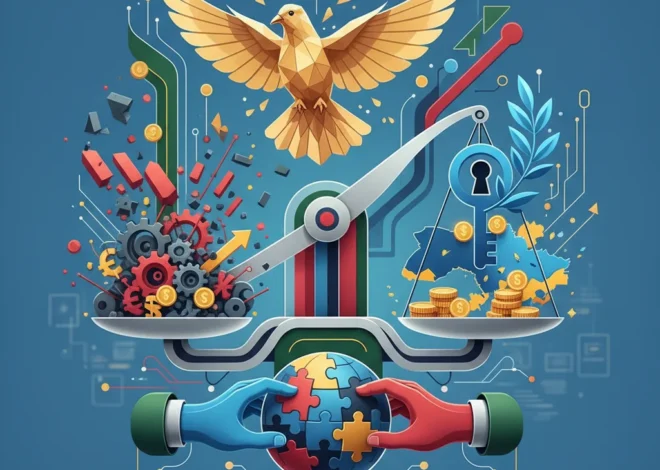
Beyond the Ivory Tower: Why Decentralized Innovation is the Next Trillion-Dollar Investment Frontier
For decades, the engine of human progress has been housed in a few select locations: the hallowed halls of elite universities, the sprawling R&D campuses of Fortune 500 companies, and the government-funded national laboratories. This centralized model of innovation gave us the microchip, the internet, and life-saving medicines. It created immense value, fueling the stock market and shaping the modern economy. But this engine is beginning to sputter.
In a recent letter to the Financial Times, Stefaan Verhulst of New York University’s Tandon School of Engineering argued that “elite institutions cannot be the sole curators of the science agenda.” He calls for a shift towards a more “open and participatory innovation ecosystem.” This isn’t just an academic plea for inclusivity; it’s a powerful signal for investors, business leaders, and anyone involved in finance. The concentration of innovation in the hands of a few is no longer just inefficient—it’s a systemic risk to economic growth and a bottleneck on breakthrough potential. A new paradigm is emerging, one that is decentralized, democratized, and poised to unlock unprecedented value.
The Gilded Cage of Centralized R&D
The traditional model of innovation is built on a simple premise: concentrate resources—capital, talent, and equipment—in one place to solve big problems. While effective, this concentration has created a gilded cage. Groundbreaking ideas are often filtered through layers of bureaucracy, corporate strategy, and academic groupthink. The result is a system that excels at incremental improvements but often stifles radical, category-defining breakthroughs.
Consider the data. A handful of corporate giants dominate global R&D spending. In 2020, the top 100 global R&D spenders alone accounted for over $900 billion in investment, representing a massive concentration of innovative power (source). This creates several critical issues for the broader economy and investment landscape:
- Risk Aversion: Large organizations are inherently risk-averse. A project with a 90% chance of failure, even if the 10% chance of success could change the world, is often a non-starter. This “safe bet” mentality leads to a portfolio of predictable, low-impact projects.
- Intellectual Silos: Ideas get trapped within corporate or university walls. The “not-invented-here” syndrome prevents collaboration, and valuable intellectual property can languish on a shelf if it doesn’t align with the institution’s immediate commercial goals.
- Geographic Concentration: Venture capital, the lifeblood of startups, is notoriously concentrated. In the US, a staggering 75% of all venture capital funding flows to just three states: California, New York, and Massachusetts (source). This leaves brilliant minds and disruptive ideas in other regions starved for capital.
For those in finance, this model has reinforced a “winner-take-all” stock market, where a few tech behemoths capture a disproportionate share of market capitalization. It forces investors to bet on incumbents, hoping they can acquire the next big thing rather than being disrupted by it. Ethereum at a Crossroads: Decoding the Battle Between Market Fragility and Whale Conviction
The Dawn of Decentralized Innovation: An Investor’s Guide
The alternative is no longer theoretical. A powerful convergence of technology and culture is fueling a move towards open, decentralized innovation. This new model distributes the process of discovery, development, and funding across a global network of individuals and organizations. The implications for fintech, banking, and the broader economy are profound.
Let’s compare the two models from an investor’s perspective. The following table breaks down the key differences:
| Attribute | Centralized Innovation Model | Decentralized Innovation Model |
|---|---|---|
| Key Players | Large corporations, elite universities, government labs | Global communities, DAOs, startups, individual researchers |
| Funding Mechanism | Corporate budgets, VC funds, government grants | Crowdfunding, token sales, decentralized grants, micro-investments |
| IP Ownership | Owned by a single entity (corporation/university) | Open-source, shared ownership via tokens, IP-NFTs |
| Risk Profile | Lower individual project risk, high systemic risk of stagnation | High individual project risk, lower systemic risk due to diversification |
| Market Impact | Incremental improvements, reinforces incumbent dominance | Disruptive breakthroughs, creates new markets and players |
This decentralized approach is already revolutionizing industries. The world of open-source software, which now powers the vast majority of the internet and enterprise technology, provides a powerful blueprint. Companies like Red Hat (acquired by IBM for $34 billion) built massive businesses not by hoarding code, but by building services around open-source platforms. This is a model that is now being applied to everything from drug discovery to advanced materials science.
Solving the Financial Crossword: A Modern Investor's Guide to a Complex World
Blockchain and Fintech: The Financial Rails for a New Economy
This revolution in scientific and technological development requires a parallel revolution in its financial infrastructure. This is where blockchain, fintech, and new economic models become critical enablers. Traditional banking and finance are too slow, too rigid, and too geographically constrained to support a truly global, fluid innovation ecosystem.
Here’s how financial technology is powering the shift:
- Decentralized Autonomous Organizations (DAOs): These are essentially internet-native organizations governed by code and controlled by their members. Research DAOs like VitaDAO are already pooling capital from around the world to fund early-stage longevity research, a field often deemed too risky or long-term for traditional pharma. They operate with a level of transparency and global participation that is impossible for a corporate R&D department.
- Tokenization of Intellectual Property: Blockchain allows for the creation of unique digital assets (NFTs) that can represent ownership of intellectual property, like a patent or a research dataset. This “IP-NFT” can be fractionalized and traded, allowing researchers to raise capital directly from a global pool of investors without selling their entire discovery to a single corporation. This creates a more liquid and accessible market for an asset class that has historically been highly illiquid.
- Smart Contracts for Collaboration: Smart contracts can automate agreements between researchers, funders, and contributors. They can automatically distribute royalties or rewards based on pre-defined contributions, ensuring fair compensation and reducing the friction of global collaboration. This drastically lowers the overhead of managing complex, multi-party research projects.
These tools are not futuristic concepts; they are being deployed today. They represent a fundamental rewiring of the economics of innovation. Instead of capital flowing from the top down, it can now flow from the edges of the network, directed by communities towards the most promising ideas, regardless of their origin. Beyond the Tariff Talk: Deconstructing the New US Trade Deals and Their Ripple Effect on the Economy
The Road Ahead: Embracing the Creative Chaos
The transition from a centralized to a decentralized innovation economy will not be neat or linear. It presents new challenges, including quality control, intellectual property disputes in a distributed environment, and the potential for fraud. However, these are solvable problems. The upside—a dramatic acceleration in the pace of discovery and a more equitable distribution of its economic benefits—is too significant to ignore.
For investors, the call to action is clear. It’s time to expand the definition of a viable investment. Look beyond the polished pitch decks from Stanford spin-offs and the predictable R&D announcements from Wall Street darlings. The next Google or Genentech may not come from a garage in Palo Alto, but from a DAO composed of a dozen anonymous researchers scattered across five continents, funded by micro-investments on a blockchain.
For business leaders, the message is one of adaptation. The “walled garden” approach to R&D is a liability in an open ecosystem. The future belongs to companies that can effectively engage with and harness the power of external networks, co-creating value with communities rather than simply extracting it. The future of the global economy depends on our ability to break down the walls of the ivory tower and build a truly open market for ideas. The tools are here; the revolution is underway.


